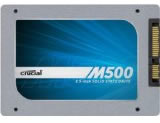
 I cloned the existing Windows 7 installation on my C drive using the free version of Macrium Reflect. My aim was to use this clone for a new Crucial 480GB SSD (Solid State Drive).
I cloned the existing Windows 7 installation on my C drive using the free version of Macrium Reflect. My aim was to use this clone for a new Crucial 480GB SSD (Solid State Drive).
I disconnected the existing C Drive and left the SSD connected. As soon as I tried to boot from the SSD I received the error autochk program not found – skipping AUTOCHECK. Despite several reboots I always got the same error message.
I entered the BIOS and set the CD/DVD to be the first boot device. I then used my Windows 7 Professional installation disk to enter and run Startup Repair. This made no difference. I noticed that the SSD did not have a drive letter allocated so I used Paragon Partition Manager to assign the drive letter D: (By now my existing disk was back in the PC and was recognized as the C: Drive).
I ran another Startup Repair to see if the drive mapping could be fixed. The Startup Repair seemed to complete successfully and on reboot my existing C: Drive started up. On checking My Computer it now showed both my existing C: Drive and my new SSD Drive as the D: Drive.
I then removed my existing drive to see if windows would now use the SSD as the boot drive and change its drive letter to C.
It started to load but defaulted to autochk program not found – skipping AUTOCHECK. If left to its own devices my PC ends up in a loop continually restarting and stopping at the skipping AUTOCHECK message.
I suspected the cloning might be at fault. So again I re-cloned the existing C: Drive to the new 480GB SSD. This made no difference, so the cloning itself was not a problem.
The only thing I could think of was a problem with the Windows installer when doing its Startup Repair. It must be seeing something different to what the cloned SSD drive set up actually shows. This could even be a continuation of the mismapping problem I mentioned earlier.
To try and fix this pesky problem I used my Windows 7 installation to get access to the recovery console. At the Install Windows screen, I clicked Next and then pressed Shift plus F10 to launch an elevated command prompt.
At the command prompt I typed diskpart to launch this handy program. When I was at the Diskpart prompt I typed list volume to show what volumes the Windows installer sees. At this point its easy to identify the real C volume by its size even if it bears a different drive letter, such as D. My own C: drive was shown as volume 2 and seemed to be mapped correctly as C:. I then exited diskpart (by typing exit). At the command prompt I typed regedit to open the Windows Registry Editor (if you lose your command prompt, Shift plus F10 will get you another one).
In the Registry Editor I selected HKEY_LOCAL_MACHINE and then clicked on File (in the menu above) and from the sub menu chose > Load Hive. I then opened the Windows\system32\config\SYSTEM file of my PC's C: drive (the SSD) and saved the file as Win32OpenHive.
I expanded the HKEY_LOCAL_MACHINE folder again.
Within it was now a folder called Win32OpenHive and an existing folder called SYSTEM.
Win32OpenHive shows you what the existing Windows 7 installation could see (not the installer), while SYSTEM tells you what the installer sees as it tries to load the Windows DVD to perform a Startup Repair.
Under each of these folders I opened the Mounted Devices sub folder to check if \DosDevices\C: had a matching ??volume. The trick here is to compare \DosDevices\C:'s Reg data entry and the appropriate \??volume in both Win32OpenHive and SYSTEM and make them exactly the same (see the images below).
![]()
![]()
So now with \DosDevices\C: and its appropriate \??volume being the same on both the Windows 7 Professional installation and the SYSTEM installer detail. I now clicked Unload the hive in the File menu, and then rebooted my PC.
I then did another System Repair on the SSD and on reboot it accessed the newly set up C: drive very quickly. What a difference an SSD makes. Faster booting, quicker program start-ups and a swift close down. A truly responsive PC!
Thanks to superuser.com whose post helped so much when putting this solution together - https://superuser.com/questions/290612/missing-autochk-program-during-boot.
Read more articles about PC repairs, Web design & SEO